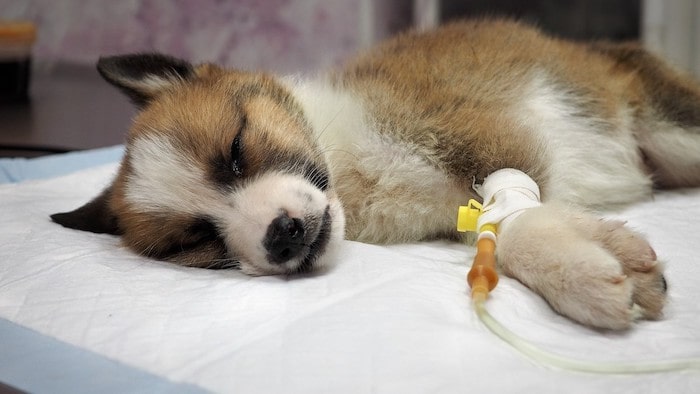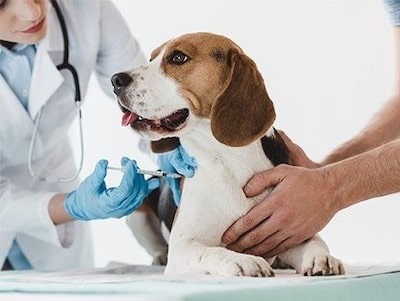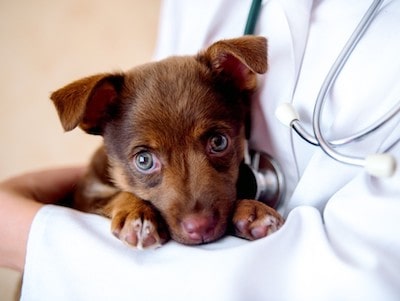If you are a dog owner, you may have heard of parvo, a highly contagious and potentially fatal virus that affects dogs, especially puppies and unvaccinated dogs.
Parvo can cause severe vomiting, diarrhea, dehydration, and damage to the intestines and bone marrow. In some cases, it can also affect the heart muscle of very young puppies.
Parvo is spread by contact with infected feces or contaminated surfaces, and can survive in the environment for a long time. The good news is that parvo can be prevented by proper vaccination and hygiene.
Here is what you need to know about parvo in dogs and how to protect your furry friend from this serious disease.
Contents
What Is Parvo in Dogs and How Does It Affect Them?
Parvo is short for canine parvovirus (CPV), a DNA virus that was discovered in the 1970s and quickly became a major threat to canine health. There are two main types of CPV: CPV-1 and CPV-2. CPV-1 is less common and usually causes mild respiratory or gastrointestinal symptoms.
CPV-2 is more prevalent and more virulent, and has several subtypes (CPV-2a, CPV-2b, and CPV-2c) that vary in their geographic distribution and pathogenicity.
CPV-2 mainly affects the rapidly dividing cells of the intestinal tract and bone marrow, leading to inflammation, ulceration, bleeding, and necrosis (death) of the intestinal lining.

This results in severe vomiting and diarrhea, often with blood, that cause dehydration, electrolyte imbalance, anemia, and protein loss. The loss of fluids and nutrients also weakens the immune system, making the dog more susceptible to secondary infections.
In some cases, CPV-2 can also infect the heart muscle cells of very young puppies (less than 8 weeks old), causing inflammation and damage to the heart (myocarditis) that can lead to sudden death or chronic heart problems.
CPV-2 can infect dogs of any age, breed, or sex, but it is more common and more severe in puppies (especially between 6 and 20 weeks old) and unvaccinated or poorly vaccinated dogs.
Some breeds, such as Rottweilers, Doberman Pinschers, Pit Bulls, Labrador Retrievers, German Shepherds, English Springer Spaniels, and Alaskan Sled Dogs, may be more prone to developing severe or fatal parvo.
How to Recognize the Signs of Parvo in Dogs
The signs of parvo in dogs usually appear within 3 to 10 days after exposure to the virus. The most common signs are:
- Lethargy
- Loss of appetite
- Fever
- Vomiting
- Diarrhea (often bloody)
- Abdominal pain
- Dehydration
- Weight loss

Some dogs may also show signs of:
- Collapse
- High heart rate
- Difficulty breathing
- Hypothermia
- Shock
Some dogs may not show any signs at all or may have very mild symptoms that go unnoticed. However, even asymptomatic dogs can shed the virus in their feces and infect other dogs.
The signs of parvo can vary depending on the type and subtype of the virus, the age and immune status of the dog, the presence of secondary infections or complications, and the response to treatment.
Therefore, it is important to consult a veterinarian as soon as possible if you suspect your dog has parvo or has been exposed to it.
How to Diagnose Parvo in Dogs
The diagnosis of parvo in dogs is based on the history, clinical signs, physical examination, and laboratory tests.
The most common test used to detect CPV-2 in the feces is an enzyme-linked immunosorbent assay (ELISA), which can be performed in a veterinary clinic or hospital.
However, this test may not be accurate if the dog has been recently vaccinated or if there is not enough virus in the feces. Therefore, other tests may be needed to confirm the diagnosis, such as:
- Hemagglutination assay: A test that detects the presence of viruses in a sample by causing red blood cells to clump together.
- Electron microscopy: A test that uses an electron microscope to visualize the virus particles in a sample.
- Polymerase chain reaction (PCR): A test that amplifies and detects the DNA of the virus in a sample.
Other tests may be performed to assess the extent of damage to the intestines, bone marrow, blood cells, electrolytes, and organs caused by parvo. These tests may include:

- Complete blood count (CBC): A test that measures the number and type of blood cells in a sample.
- Biochemistry profile: A test that measures the levels of various substances in the blood, such as glucose, protein, electrolytes, enzymes, and bilirubin.
- Urinalysis: A test that evaluates the physical, chemical, and microscopic properties of urine.
- Abdominal radiographs (X-rays): A test that uses X-rays to produce images of the abdominal organs and structures.
- Abdominal ultrasound: A test that uses sound waves to create images of the abdominal organs and structures.
How to Treat Parvo in Dogs
There is no specific treatment for parvo in dogs, and the current standard of care is supportive care, which aims to correct the dehydration, electrolyte imbalance, anemia, protein loss, and secondary infections caused by the virus.
Supportive care often involves hospitalization and intensive monitoring, and may include:
- Fluid therapy: The administration of fluids intravenously (IV) or subcutaneously (under the skin) to rehydrate the dog and restore the electrolyte balance.
- Antiemetics: The administration of drugs that prevent or reduce vomiting.
- Antibiotics: The administration of drugs that fight bacterial infections that may complicate parvo.

- Antiparasitics: The administration of drugs that eliminate parasites that may worsen parvo, such as intestinal worms or coccidia.
- Nutritional support: The administration of nutrients orally, IV, or through a feeding tube to provide energy and protein to the dog.
- Blood transfusion: The administration of blood or blood products IV to treat severe anemia or bleeding.
- Pain relief: The administration of drugs that reduce pain and inflammation.
- Immunomodulators: The administration of drugs that stimulate or suppress the immune system, such as interferon or corticosteroids.
The survival rate of dogs with parvo depends on several factors, such as how quickly the diagnosis is made, how aggressive the treatment is, how old the dog is, and how well the dog responds to treatment.
In general, the survival rate ranges from 68% to 92%, with higher rates in dogs that receive early and intensive treatment.
However, some dogs may not survive despite treatment, especially if they develop severe complications such as septic shock, disseminated intravascular coagulation (DIC), or myocarditis.
How to Prevent Parvo in Dogs
The best way to prevent parvo in dogs is by vaccination. Vaccination is a safe and effective way to protect dogs from parvo by stimulating their immune system to produce antibodies against the virus. There are different types of vaccines available for parvo, such as:
- Modified live vaccines (MLV): Vaccines that contain a weakened form of the virus that cannot cause disease but can still induce immunity.
- Killed vaccines: Vaccines that contain an inactivated form of the virus that cannot replicate but can still induce immunity.
- Recombinant vaccines: Vaccines that contain a genetically engineered form of the virus or a part of it that can induce immunity.
The vaccination schedule for parvo may vary depending on the type of vaccine, the age and health status of the dog, and the risk of exposure to the virus.
In general, puppies should receive their first vaccine between 6 and 8 weeks of age, followed by booster doses every 3 to 4 weeks until they are 16 to 20 weeks old.

Adult dogs should receive a booster dose every year or every 3 years depending on the type of vaccine and the recommendation of the veterinarian.
Vaccination alone may not be enough to prevent parvo in dogs, especially in puppies that have not completed their vaccination series or in dogs that have a weak immune system.
Therefore, other preventive measures should be taken to reduce the risk of exposure to the virus, such as:
- Avoiding contact with infected dogs or their feces
- Keeping puppies away from public places or other dogs until they are fully vaccinated
- Cleaning and disinfecting any surfaces or objects that may be contaminated with parvo using bleach or specialized cleaner
- Washing hands and changing clothes after handling infected dogs or their feces
- Isolating infected dogs from other dogs until they are no longer shedding the virus
- Spaying or neutering dogs to prevent unwanted pregnancies and transmission of parvo from mother to puppies
FAQs
Can parvo be treated?
Yes, parvo can be treated, but it requires prompt and intensive veterinary care. Treatment often involves supportive measures such as intravenous fluids to combat dehydration, anti-nausea medications, and antibiotics to prevent secondary infections. The earlier treatment is initiated, the better the chances of survival.
Can adult dogs get parvo, or is it only a concern for puppies?
Adult dogs can also contract parvovirus, but puppies, particularly those between 6 weeks to 6 months old, are at higher risk due to their weaker immune systems. Unvaccinated adult dogs are also susceptible to the virus.
Is parvo contagious to other animals or humans?
Parvovirus is specific to dogs and does not infect other species, including humans. However, humans can unknowingly carry the virus on their clothes or shoes, potentially transmitting it to unvaccinated dogs.
Can my dog get parvo more than once?
Dogs that have successfully recovered from parvo usually develop immunity to the specific strain they were infected with. However, they may still be susceptible to other strains, so vaccination remains important even for previously infected dogs.
Well, That’s a Wrap
In conclusion, parvo in dogs is a serious and highly contagious viral disease that requires immediate attention and proper veterinary care.
Prompt recognition of symptoms, early treatment, and vaccination are essential in safeguarding your furry companion against this potentially life-threatening illness.
Remember, prevention is always better than cure, so stay proactive in keeping your dog’s vaccinations up-to-date and maintaining a clean living environment.
By being informed and proactive, we can protect our beloved canine friends and ensure they lead happy, healthy lives free from the threat of parvo.

A retired veterinary technician and full-time dog parent. James knows to serve the community with the best of his knowledge of animal healthcare. He has been working in a known veterinary clinic for quite a few years. He loves reading blogs on pet nutrition and writes unbiased reviews of dog products.


